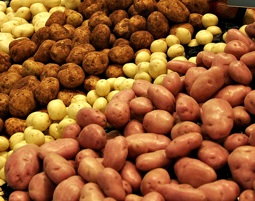
Features
Production
Research
There’s more to the potato than meets the eye
October 31, 2008 By Agriculture & Agri-Food Canada
 October 31, 2008, Fredericton, NB
October 31, 2008, Fredericton, NB
– For years, scientists at Agriculture and Agri-Food Canada (AAFC) have
had a history of success in studying potatoes – creating new varieties,
enhancing production systems and developing new systems for pest and
disease control. This and other Agriculture and Agri-Food Canada
research will be featured at the Royal Agricultural Winter Fair in
Toronto, November 7 to 16.
October 31, 2008, Fredericton, NB – For years, scientists at Agriculture and Agri-Food Canada (AAFC) have had a history of success in studying potatoes – creating new varieties, enhancing production systems and developing new systems for pest and disease control. This and other Agriculture and Agri-Food Canada research will be featured at the Royal Agricultural Winter Fair in Toronto, November 7 to 16.
 “The potato is very diverse,” says Dr. Richard Tarn, an AAFC research scientist who has four decades of experience in the field at the Potato Research Centre in Fredericton, New Brunswick. “There are over 7,500 different potato varieties from around the world in the collection at the International Potato Centre in Peru, and our own Potato Gene Resources Repository here in Fredericton has over 100 potato selections of scientific and historical importance to Canadian agriculture. It has been a valuable source of genetic information to help me develop new potatoes for Canada.”
“The potato is very diverse,” says Dr. Richard Tarn, an AAFC research scientist who has four decades of experience in the field at the Potato Research Centre in Fredericton, New Brunswick. “There are over 7,500 different potato varieties from around the world in the collection at the International Potato Centre in Peru, and our own Potato Gene Resources Repository here in Fredericton has over 100 potato selections of scientific and historical importance to Canadian agriculture. It has been a valuable source of genetic information to help me develop new potatoes for Canada.”
Originally potato researchers targeted the development of varieties with the characteristics requested by growers and processors. Today, scientists are focusing more on consumer demands by developing new cultivars with specific nutrition, flavour and texture characteristics.
Dr. Benoit Bizimungu is an AAFC research scientist who works at the Lethbridge Research Centre in Alberta. He explains that potato breeders now take a number of different factors into consideration. “We look at ascorbic acid (vitamin C), antioxidants, and proteins, while improving flavour and texture to create more appealing and healthier potatoes,” he says.
He notes that work is also in progress to select low Glycemic Index potatoes and to produce varieties with enhanced levels of antioxidants, natural compounds associated with lower incidence of chronic diseases such as cardiovascular disease, certain cancers and eye diseases.
On another research front, Dr. Qiang Liu and Agnes Murphy lead a team of AAFC food scientists. Their research on the nutritional quality of potatoes emphasizes the antioxidant content (which provide natural colour pigments), and the starch properties which impacts on the Glycemic Index of potatoes.
“Antioxidant levels are highest in varieties with purple and red pigmented flesh,” says Murphy at the Potato Research Centre in Fredericton. “Research in Canada and the United States has developed pigmented flesh selections with antioxidant levels more than four times those of current commercial varieties. These may be the varieties of choice for the future.”
From developing new varieties to improving nutritional, flavour and texture characteristics, there is significant Canadian research to ensure the long-term viability of this crop that helps feed the world. It’s no wonder that the United Nations has designated 2008 as the International Year of the Potato. In fact the potato is only the second crop, following rice in 2004, to receive this noteworthy recognition in a year-long celebration.
Print this page